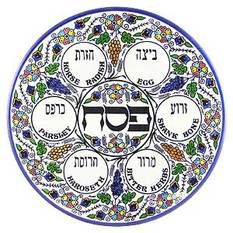The Seder begins with everyone seated at a beautifully set table, covered with a white tablecloth as a reminder of the bright sand of the Sinai desert and decorated in blue and gold with cheerful spring flowers and candles. At the head of the table are arranged the special Passover elements:
- Three matzot, hidden under a cover or napkin, as a reminder of the unleavened bread the people of God carried as they fled Egypt.
- A wine goblet for use in ceremonial greetings throughout the Seder.
- A special ceremonial wine goblet, the Cup of Elijah, covered with a napkin and set out in a prominent place in front of the leader.
- The ceremonial Seder platter with six symbolic foods:
- The shank of a lamb, as a reminder of the Paschal lamb.
- A roasted egg, symbolic of the peace offering that accompanied the sacrifice of the lamb.
- Bitter herbs or horseradish, calling to mind the bitterness of slavery.
- Haroset, a food made of apples and nuts mixed with wine and cinnamon to look like the mortar that the Hebrew slaves used.
- Greens, parsley or watercress, to remind us of the promise of new life which bursts forth from God’s bounty each spring.
- A dish of salt water into which the greens will be dipped, as a reminder of the tears shed by the slaves.
- A bowl of water with a small towel for ceremonial washing.
- A small pillow on the leader’s chair, symbolic of the luxury of freedom since slaves were not allowed to eat at their leisure while free men could dine comfortably.




